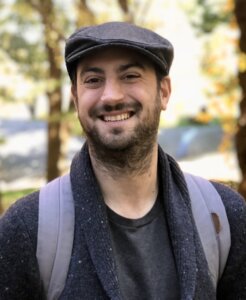How 770 Eastern Parkway became the world’s most-recognizable Jewish building
Three dozen replicas of the building are located around the world

A Holy Place: Rabbis prepare to pose a group photo, part of the annual International Conference of Chabad-Lubavitch Emissaries, in front of Chabad Lubavitch World Headquarters November 19, 2017 in Crown Heights. By Getty Images
Its trio of red-brick gables can be found in Australia, India and El Paso, Texas. You can find images of the Gothic Revival building on tallis bags, mezuzahs and tzedakah boxes. Around the world, construction is underway on at least six more replicas of 770 Eastern Parkway, the Brooklyn-based headquarters of the Chabad-Lubavitch Hasidic movement. And, when the building in Abuja, Nigeria, is finished, there will be at least one on every continent except Antarctica.
But what has become an epicenter of Jewish life was not intended to turn into a religious icon. Built nearly a century ago as a private residence and medical clinic next to the Kingston Avenue subway station, 770 became the home of Rebbe Yosef Yitzach Schneersohn and was later where his son-in-law, Rebbe Menachem Mendel Schneerson, had his offices. This has made the building a spiritual icon for perhaps the fastest- and widest-spreading branch of Judaism. Though its limestone window surrounds, stained glass and bay window protruding from the facade may seem unremarkable, 770 might just be the most replicated building in all of New York City.
“This was the rebbe’s home that he was giving over and opening up to the community,” said Eli Meltzer, principal architect of Meltzer/Mandl Architects and a Lubavitch Hasid who designed the newly-opened 770-inspired Chabad Center in El Paso. “At some point, the building became enshrined symbolically, and then you don’t want to change it.”

Deep in the Heart of Texas: Rabbis stand before a 770-inspired Chabad Center in El Paso, Texas, designed by architect Eli Meltzer. By El Paso Chabad
There are currently 35 duplicates of 770. They vary in style and in how they are used. Most serve as Chabad Houses, centers of outreach, but a private home and a restaurant in Israel also copy the Brooklyn synagogue. The buildings range in fidelity to the original. In Kfar Chabad near Tel Aviv, there is a brick-by-brick duplicate inside and out. The Chabad House close to the Dalai Lama’s home in Dharmasala, India, mixes key elements of the Brooklyn 770 with the local style of bright colors and wrap-around balconies.
“Spiritually thinking, everyone would love to have an exact replica,” said Meltzer. “But there are no rules.” Builders, he added, must contend with red tape, budgets and the functional demands of the building. Some are built from the ground up, while others are merely conversions of already-existing structures.
A Place for all Jewish People

The Building That Started It All: 770 Eastern Parkway, Chabad Lubavitch World Headquarters By gettyimages
The original 770, where Rebbe Schneerson, the revered Lubavitch leader, worked, was also where he was cared for after his stroke in 1992. He died two years later, having remained there for most of the rest of his life. Without almost ever leaving Crown Heights, the rebbe employed 20th century techniques to promote 18th century religious thinking — rebuilding his community after the Holocaust and leveraging modern media to engage Jews worldwide.
Fittingly, the building, sometimes called “the flagship synagogue,” has become a sort of corporate logo. Like the McDonald’s golden arches, 770’s three-peaked roof is as much a trademark as it is an architectural motif. It appears on party favors and wall clocks.
Despite its pop-culture-like status, for the Lubavitch faithful, it is a symbol of more than just Chabad. “The rebbe was the leader of all Jews,” said Motti Seligson, Chabad’s director of media relations. “770 is for all Jewish people.”
Secular Jews or those affiliated with other movements may bristle at being identified so closely with the Hasidic movement, but Seligson has an argument. In many parts of the world, Chabad is the only Jewish presence and a recent Pew Research report found 37% of American Jews have participated in a Chabad service or activity — proving the effectiveness of the flotilla of mitzvah vans and cadres of Yeshiva boys asking passersby, “Are you Jewish?” Indeed, while Lubvavitch leaders are generally the ones who spearhead copies of their headquarters, significant funding comes from non-Orthodox Jews.
Nothing about the building, which could easily blend in on a New England college campus, is particularly Jewish. Still, the Lubavitcher Hasidim interviewed for this article consider it an icon of Judaism. Long a site of pilgrimage, it is seen as the closest thing to the Temple in Jerusalem.
A Chabad-affiliated website features photos of small silver 770s used as Torah crowns and Torah arks made in the image of 770 — spaces usually reserved for age-old Jewish images like menorahs and shofars, not a modern building by a Long Island architect who was born Jewish but raised his children Episcopalian.
The Story Behind the Building

Standing Out in a Crowd: A 770 replica in Sao Paulo, Brazil. By Robbins/Becher
For a Jewish Museum exhibit in 2005, Andrea Robbins and Max Becher photographed the first dozen 770s and they have since continued to visit new ones. “None of them are exact,” said Robbins, who finds each variation and location gives the collegiate-style house new meaning. The photo project, Robbins said, “was a way of looking at Orthodox Jewish religion as something that is actively changing, as opposed to a static antique position.” The artists’ close-ups reveal slight differences between the duplicates, while striking panoramas show the building in unexpected contexts.
In Jerusalem, the red building dramatically stands out against a sea of white houses. It’s the inverse of world synagogues that use Jerusalem stone to connect back to the holy city. There, from within Israel, the Lubavitch use brick to show their center is Brooklyn. In São Paulo, a 770 is shoehorned between two skyscraper condominiums. It appears as out of place as a black-hatted Hasid in Ipanema.
But, though a bearded Lubavitcher is visibly Jewish, the 770 replicas, without any markings, are what Robbins called “signposts hiding in plain sight.” For initiated Jewish travelers, they announce a Shabbat dinner and a minyan, but locals may find the buildings bewildering. In 2019, the Italian newspaper, Corriere della Sera, reported that locals call Milan’s 770 “l’olandese,” the Dutchman, associating the look with Amsterdam.

Inauspicious Beginnings: In the mid 1930s, a Jewish medical doctor, S. Robert Kahn, commissioned the respected architect Edwin Kline to build him a private residence and clinic on Eastern Parkway, then home to affluent assimilated Jews. Courtesy of Andrew Silverstein
In truth, the building was meant to compete with other similarly-styled houses in Crown Heights. In the mid 1930s, a Jewish medical doctor, S. Robert Kahn, commissioned the respected architect Edwin Kline to build him a private residence and clinic on Eastern Parkway, then home to affluent, assimilated Jews. Kline, who was born and educated in Buffalo, made a name for himself designing large Tudor homes in wealthy New York suburbs.
One in Kings Point, Long Island, was built for Broadway lyricist Oscar Hammerstein and later owned by comedian Alan King. The building for Kahn was completed in 1936. “My grandfather had to take him to court to get full payment,” said the architect’s granddaughter Susan Kline, a retired educator, who is proud to see how the design has proliferated worldwide.
Dr. Kahn’s legal troubles did not end there. Court and newspaper records show that in 1937 he lost his medical license for carrying out illegal abortions on Eastern Parkway. The following year, he was charged with homicide after a Bronx woman died during an “illegal operation.” He was cleared of the charges but was later implicated in the bribing of the Brooklyn judge assigned to the case.
Then in 1939, Kahn pleaded guilty to tax evasion and was sentenced for two and a half years to a federal prison in Lewisburg, Pennsylvania. Upon release, he settled with his family in the wealthy region of Great Neck, Long Island. He supposedly became a chauffeur, but in 1951 was arrested for practicing medicine without a license and performing abortions in his kitchen at $1,000 each.
During all of Kahn’s legal woes, his property was repossessed by the bank. In August, 1940, the small contingent of Lubavitchers in New York purchased it to be the home and office of Rebbe Yosef Yitzach Schneersohn. The main reason was practical: Rabbi Yosef Schneersohn, who escaped Nazi-occupied Europe, was wheelchair-bound and 770 had an elevator. Also, the location on Eastern Parkway, which a 1939 guidebook compared to the Champs Élysées, added prestige. According to Chaim Miller’s biography of Schneerson, “Turning Judaism Outward,” Jewish neighbors resisted the sale fearing that Hasidim would lower property values.

A Detail From 770: A view onto Eastern Parkway through a stained glass window at Chabad headquarters. By Andrew Silverstein
The downstairs clinic became an Orthodox synagogue, and a cross in a decorative stained-glass window was scratched off with a pocket knife. Ten years later, Rabbi Yosef Schneersohn passed away and his son-in-law, Rabbi Menachem Mendel Schneerson, assumed leadership. Eventually, extensions were added, but otherwise, 80 years later, the main building is unchanged. For what is considered a sacred place, the interior is surprisingly underwhelming. In 2003, The New York Times magazine compared the basement synagogue to “a junior-high-school cafeteria.”
Its humbleness, though, is part of the appeal. Architect Meltzer, who prays at 770 weekly, compares it to a shtiebel, an informal place of prayer established in private homes, popular amongst Hasidim.
When the rebbe consecrated the building, what was secular became sacred. Even the building’s number took on new meaning. Lubavitchers request phone numbers with the address and use it in their passwords — 770 equals the numerical value of the phrase “House of the Messiah” in Hebrew. Yeshiva students draw parallels between the three pediments and the Talmudic precept that the world rests on three pillars: Torah, divine service and charity. They infer religious meaning from the architecture while aware of the building’s less-than-holy origins. “There is the element of divine providence,” Seligson said.
What All These Copies Mean

Faithful Copy: The Kfar Chabad near Tel Aviv duplicates the original design brick-by-brick inside and out By Robins/Becher
It’s hard to pinpoint what the 770 replicas are meant to signify. The first duplicate was a memorial at UCLA in 1984 after the University’s first Chabad House burned down, claiming the lives of three students. “In planning to rebuild, the [UCLA] rabbi had the idea that three “points” on the roof would honor the three students,” Meltzer wrote in the architectural journal, “Faith and Form.” Still, the building does not attempt to be a full replica. It is of a brownish brick and the first floor, in true Los Angeles fashion, is a parking garage.
A nearly-exact 770 copy would come in Kfar Chabad, Israel, three years later, built on the direct orders of the rebbe. “Two Chabad architects from Israel accepted the commission, which they undertook as a religious mission,” Maya Balakirsky Katz wrote in her book “The Visual Culture of Chabad.” The architects, she recounted, “flew to Crown Heights to photograph and diagram every inch of the building in meticulous detail.” They even went through the trouble of securing the building number 770.
Still it’s not identical. The pear tree in front didn’t take root, so a local tree was planted in its place. Otherwise, it’s as if Edwin Kline’s 1936 building, complete with the irregular pattern of hand-laid bricks, was transplanted to a vast Israeli parking lot.
The rebbe gave no reason to make his replica, but scholars believe it was related to a court battle over his father-in-law’s library. The previous rebbe’s grandson staked a claim on the rare texts. Schneerson’s lawyers argued that the books belonged to the organization of Chabad and not to the previous rebbe as a private individual.
While this was a legal argument in a non-religious court, Balakirsky Katz sees it as a philosophical departure from tradition that treats rebbes as absolute monarchs of Hasidic courts. Essentially, Chabad was saying that the possession of the kingdom is property of the people and not of the king. Balakirsky Katz believes that by duplicating 770, Schneerson reinforced the decoupling of the institution and the rebbe. This, she argues, set the stage for Chabad to continue without a rebbe after Schneerson’s death. “I would say the rebbe didn’t name a successor because 770 was his successor,” Balakirsky Katz said.
Samuel Heilman, co-author of “The Rebbe,” a critical biography of Schneerson, seems to agree. “It’s an icon that stands for a missing person,” he said, citing the burst of replicas that appeared around the time of Schneerson’s death. “It’s a way to demonstrate his absence and his presence.” Seligson, however, rejects the idea that 770s are a stand-in for Schneerson. He believes the replicas simply represent the rebbe’s teachings and devotion to the Jewish people. “They symbolize Ahavat Yisrael,” the love of one’s fellow Jews.
Still, for some who believe the Rebbe is the Messiah himself, the replicas are not mere symbols.
More Than Just a Symbol

Conforming to Local Design Standards: In 2019, the Italian newspaper Corriere della Sera, reported locals called Milan’s 770 “l’olandese,” the Dutchman, associating the look with Amsterdam. By Robbins/Becher
Bayes Garelick and her husband, Rabbi Gershon Garelick, became emissaries in Milan in 1958 and built a 770 replica in 1994. In a YouTube video titled, “Why a replica of 770 Eastern Parkway was built in Milan, Italy,” she recounted a meeting with the rebbe. “As I’m walking out, the rebbe says ‘Until the Moshiach comes, either first in Melbourne or Milano,’” she recalled, using the Hebrew word for messiah.
“That is when we made the 770,” she said because Rabbi Garelick beleived, “when the Rebbe comes he has to have somewhere to go to.”
Even with so much at stake, the Milan 770 doesn’t stay true to the original design. It had to conform to rigid European standards. The signature bay windows jutting out on the second floor were replaced by an Italian-like balcony. Other replicas have met similar bureaucratic challenges. A waiver had to be finagled in Jerusalem, and American 770s have wider entrances to meet accessibility requirements.
The buildings are also not shrines. They may include community rooms, apartments, ritual baths and kosher kitchens. Some are multiple times larger than the original and test the limits of what a 770 is. The one in Rutgers gains space by repeating the front façade, while others distort the Brooklyn building’s proportions, and vary the materials. Meltzer, in El Paso, decided to make his look-alike two stories, not three, and use Jerusalem stone for part of the front, connecting it to two holy sites.
The El Paso 770 was a project for the local Chabad emissary, Rabbi Yisroel Greenberg, who is Garelick’s son-in-law. When I asked him, if like his in-laws, he hopes the Messiah will come to his newly opened 770, he deadpanned, “I don’t think the Moshiach is necessarily coming to El Paso.” Hedging his bets, he added, “but if he does, the doors are open.”
His in-laws, he explained, are of a different generation. For Greenberg, the choice of replicating the 770 façade was simple. When he came from Israel to study in Crown Heights in the 1970s, he saw the Chabad headquarters as a place where Jews and non-Jews come “to listen to the message of Judaism from the rebbe.” That is what he wants to emulate. “The icon of Judaism is 770,” he said.
That 770 means different things to different people may be the point. Chabad aims to spread the teaching of the rebbe to all Jews from its most faithful members to the least observant. The building, Balakirsky Katz points out, is a flexible and neutral image.
“It can serve as an umbrella for all these diverse internal ideas and both unite and be meaningful to each person individually,” she said. It is also useful for a media-centric group. Unlike the rebbe’s portrait, Chabad’s most popular image, the building can be abstracted and reproduced in any context: Kiddush cups, postage stamps, it even has been made into a children’s bouncy castle.
At one point, Schneerson himself propelled the Chabad movement around the world. Since his death, the movement continues to grow and find inspiration in his teachings. The rebbe is no longer present but he left his words to spread, and his building.
Editor’s note: This story has been updated to clarify that Menachem Mendel Schneerson worked at 770 and was later cared for there after suffering a stroke.
Andrew Silverstein writes about New York City and is co-founder of Streetwise New York Tours.
























